The Seven Days Creation in the Bible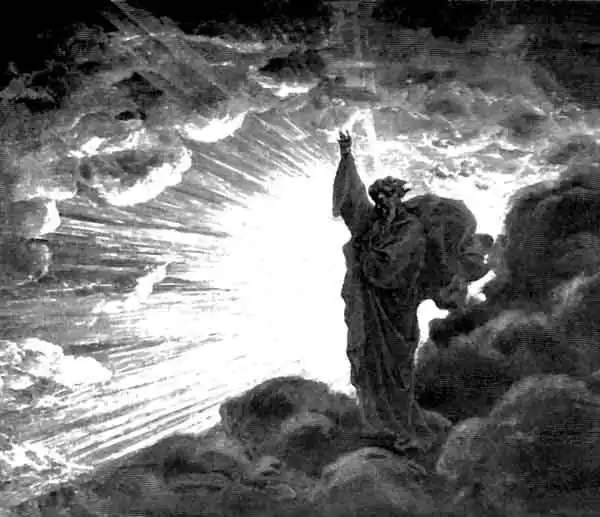
Genesis 1 Creation Examined, part 2
2 The seven daysAt the outset
The word for God in all of Genesis 1 is Elohim, which is actually a plural: the Gods. Its singular form is Eloah. The meaning of this plural has been discussed greatly, and there is no complete agreement as how to interpret it. It indicates all the Gods, which can be seen as a way to express an excluding thesis: there is no other God, none outside this entity. |
by Stefan Stenudd |
The King James Bible capitalizes the G, when the word refers to the Israel god. Although the word is plural, the Hebrew text frequently combines it with a verb in singular form, indicating one God for all. This is also done in Genesis 1:1, which in Hebrew reads: "Bereishit bara Elohim et hashamayim ve'et ha'aretz." The verb bara, meaning filled or fattened, indicates third person masculine. For a plural, it would have been baru.
Notice that a word-by-word translation of the Hebrew verse reads: "(In the) beginning filled God the heavens and the earth." To fill and to create are certainly no synonyms. Filling something indicates its preexistence. So, the heavens and the earth seem to be seen as spaces. Bara is used 48 times in the Hebrew Bible, and normally signifies a divine action, so it might be more correctly translated as "fulfilled", or "completed", in the sense that an empty vessel was given substance and meaning. It implies that there was a preexisting void, barren and dark, until God filled it with substance, light, and life.
This would also diminish the contradiction between the first verse and the following, where God is said to create heaven on the second day. He is not likely to have created it twice, but he could have filled a preexisting heavenly vessel, just like he later filled the earth with all kinds of things and beings.
The word bara is also used in verse 21 and 27. In other instances, the word asah, "to make", is used. The words seem not to have been used for different purposes, but as synonyms. For example, in verse 26 God intends to make (asah) man, and in the next verse creates (bara) him. The word bara is used for divine creation, whereas asah can be manmade.
The very first word in the Hebrew text, bereishit, does not exactly mean "the beginning", but approximately "at the head" or "at the top", which would in this case be something like "at the outset" or "at the starting point", but it might also imply something similar to "from above", bringing it quite near to the opening words of the Babylonian creation epic Enuma Elish, which starts with the words "when above".
The heaven of the first verse is actually a plural — the heavens. It is a dual of a singular that is not used, meaning the lofty or the sky, again implying a space rather than an ether. There is no consensus in explaining the dual. It might refer to the near sky, where clouds sail, and the far one, where the stars are seated. It might also refer to the day and night skies, separated in the verses 4 and 5.
The first verse is not likely to present an action of God in itself. It can be seen as a header, introducing what will take place in the following text, or it can be read as connecting to the next verse, such as: "When in the beginning..." or "In the beginning, as God created..."
So, the first verse of Genesis 1 describes no action of God, but presents what is to come. Therefore, we have to go to the second verse to see what the initial state of the world was, before God commenced his work.
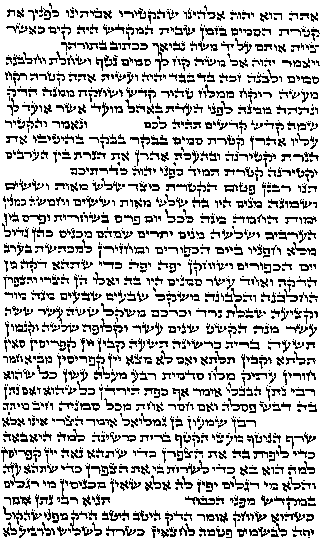
Page from the Torah in Hebrew.
The initial state
Genesis 1 : 2
The second verse describes the world as it is before God starts his acts of creation. The expression "without form" is the Hebrew word tohu, meaning a desolate waste, a barren place — obviously a world on which God has not yet brought his blessings. Void, bohu, implies the same. The word refers to emptiness. Land exists, but there is nothing on it. The darkness also points out that this is the state of things before God starts to act. The face of the deep must be the surface of the primordial sea. The deep, tehom tehom, could be translated "deep depth", an abyss of so much water that neither the end nor the bottom of it can be seen.
The primordial world is one of water, only. Land appears in verse 9. Such a primordial sea is common in creation stories around the world. One near at hand to the Hebrews is the Babylonian creation Enuma Elish, which also commences with a world of water.
In the darkness above this sea, God's spirit moved, rachaph, indicating that it was done in a relaxed way, brooding there calmly before deciding on a change. There is no day or night yet, so this brooding cannot be timed. Both the primordial sea and the spirit of God are present in the dark eternity preceding the creation of the world as we know it. Nothing is said or implied about God's origin or his role in this void.
It is not God roaming over the water, but his spirit, ruach. This word signifies wind and breath, especially exhalation. The breath of life. It is not God himself moving over the water, but his spirit. This indicates that they are separate entities, and that God is elsewhere — distanced from the world he is about to create.
He cannot be in this void, or he would be little more than part of it, unable to change it radically — at least without some means. Since he uses none in the creation process to follow, it is necessary for him to work from outside — wherever that is.
This spirit of God seems to be an essence of his, as described in both Genesis 1 and 2, and all through the Bible. It is no doubt his ability to initiate life, similar to the primal mover of Aristotle. It can be described as his will, or the agent by which it is accomplished. Its link to breath also gives a reason for his use of words, of speech, in accomplishing each feat of his creation. We speak with our exhalation. When God orders things to appear by pronouncing his wish, he definitely uses his breath. The creative instrument, then, is not the word he speaks, but the exhalation of his spirit as he utters it.
That also brings a kind of sense to his spirit's hovering over the abyss in the second verse. Spreading his breath over the void is his way of commencing his structuring and ordering of it. His will-power is extended to it, and next the changes begin. This would be a God from another world, finding this void and wanting to change it, mold it into something of his liking.
The first act of creation
Genesis 1 : 3-5
In the third verse, God makes his first act of creation. He orders light, or, to appear. His command is enough to make it happen. He wishes it. Then he observes the result, and is pleased with it.
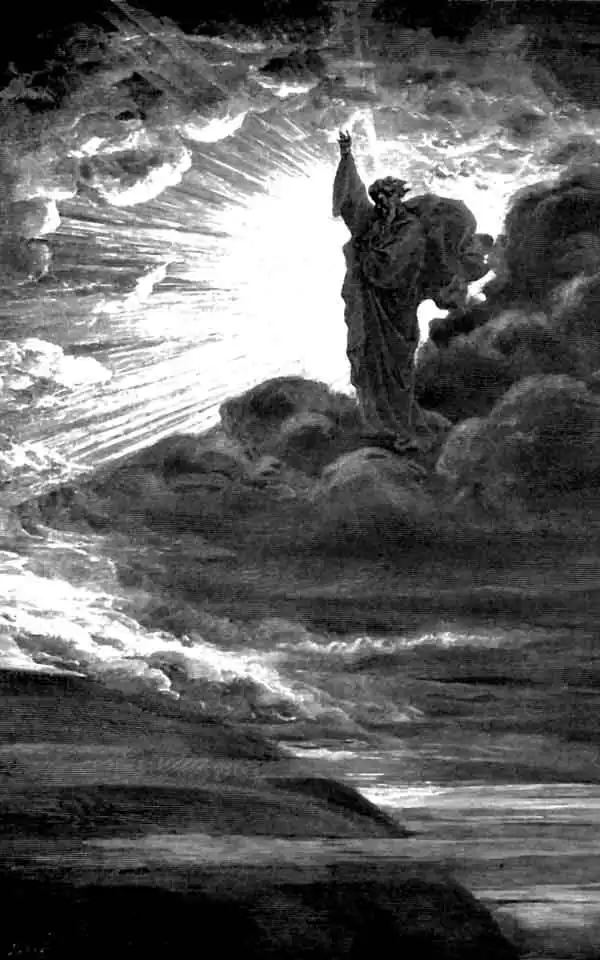
"Let there be light!" Bible illustration by Gustave Doré, 1866.
This is light as a kind of entity, something opposed to darkness, in no need yet of the sun or any other source. It would be the light of dawn, if this was regarded as something separate from the brilliance of the sun appearing over the horizon. Since the morning light arrives long before the sun is visible, that order makes sense.
God continues by separating the light from the dark, calling the former day and the latter night. This is what his first act of creation is all about: creating day to take turns with the formerly eternal night. He initiates the very first dawn. By awaiting the following dusk and dawn he has the cycle completed.
Yet, it is odd that he does not create the sun until day four. Man has always been able to observe its rulership over day and night, and most ancient cultures have readily admitted it. This separation of daylight from its celestial source sets Genesis 1 apart from most creation myths. Maybe the intent was to lessen the importance of the sun, which is almost inseparable from the highest deity in many other traditions. The use of the divine plural together with verbs in their singular forms suggests that Genesis 1 is part of a process from polytheism to monotheism. Robbing the sun of its brilliance by making day without it, might be part of such a process, like a dethroning of a previous high god identified as the sun — such as in Egyptian mythology.
Another possibility, although not that evident, is that this might be the result of a tradition regarding God as light itself. Through the Bible, he is often enough linked to light, implying a world without him being one covered in darkness. His spirit might be hovering over the dark abyss, but when he himself arrives, so does light. That is why this is the first act of his creation. He brings light, because that is what he is. By his arrival, he conquers darkness.
Light is definitely essential to the God of Genesis 1. So is his spirit, discussed above. A being of light would definitely want to spread it over any dark place he came across. He would do it just by approaching it, like the sun rising in the morning. The impenetrable and therefore chaotic darkness is lightened up by a creature of light, making it visible and thereby giving it detectable form — bringing it to order. Such a being would naturally continue to order things and bring them into the state they have now. In this perspective, a being of light is by necessity also one of order. He would create the world, whether it was his intention or not.
The second day
Genesis 1 : 6-8
God continues with celestial arrangements. On the second day he divides the primordial waters into one terrestrial and one celestial ocean. This division is done by a firmament, raqiya, an expanse which is the arch that the sky forms over our heads.
He calls the firmament Heaven, wherein the text uses the same word as in the first verse. This implies an inconsistency, since the first verse states either that God has already created Heaven, or that it existed prior to his creative acts. This inconsistency is also present with earth, mentioned in both the first and the second verse, although God makes it appear in verse 9. Clearly, though, the earth is regarded as hidden under the primordial sea, so it is not created as much as exposed when the water is moved away from it. Something similar is true for Heaven. It exists as a space, prior to God's acts, so what he does is to arrange it and give it substance. He fills it.
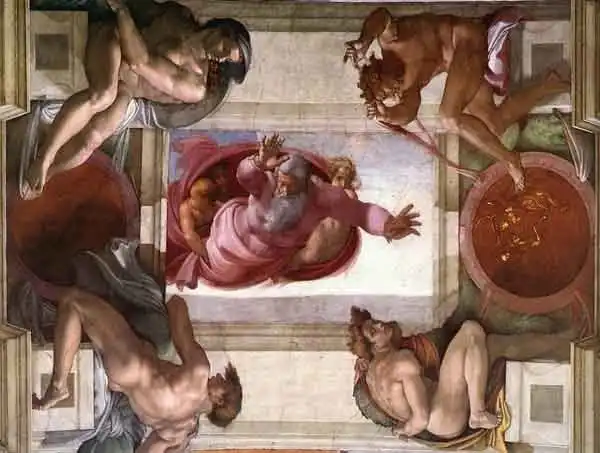
God divides heaven from water, by Michelangelo 1509.
If we regard God as a being of light, whose main act of creation is simply lighting up a world previously covered in darkness, the firmament would simply be visible by his arrival. He would not need to create it, if the space was already there, but expose it to any eye. Such a God is not a maker of the world, but a presenter of it. By his light he makes the world and its components appear, and by his breath of life he gets it moving.
The third day
Genesis 1 : 9-13
Next day, in accordance with the order given in the first verse, God moves the water below the firmament, so that the dry land under it becomes visible. The water is arranged into seas. As soon as the earth is bared, he fills it with vegetation.
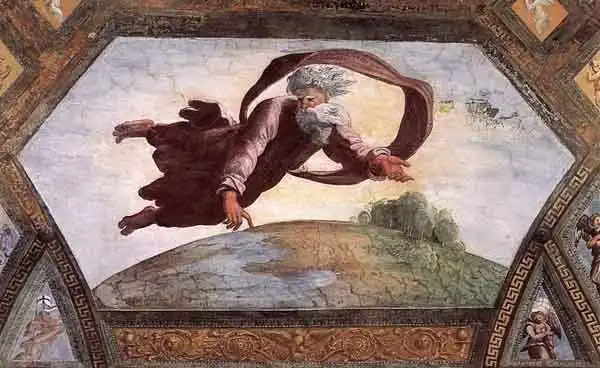
God separates the land from the water, by Raphael Sanzio 1519.
Again it is possible to see the process of creation as one ignited by the entrance of light. Ancient man was able to see how the heat from the sun makes water evaporate. So does another light that he must have been familiar with — that of fire. When the water moves so that land appears from below, this could easily be explained as caused by the heat from the sun, if it were not created on the following day. Still, light was created already on the first day, so whatever the nature of that primary light, it could very well be the agent of drying up the land.
This would also explain why the vegetation is created as soon as the earth is exposed. Light and warmth make plants grow from the ground. Immediately when the earth is uncovered from the darkness of the primordial sea, this is bound to happen. And again we have a creator God who does not really have to create that much. His appearance in the world ignites the processes.
The fourth day
Genesis 1 : 14-19
The following day God creates the stars in the sky, as well as the sun and the moon. These are all placed on the firmament, so it is strange that this part of creation was not done on the day following that of making the firmament. The reason for this order is probably the importance of the opposites heaven and earth. When one has been created, the other must come next.
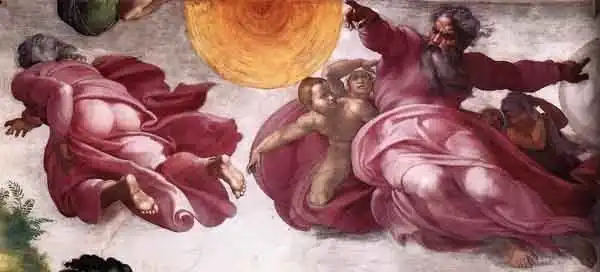
God creates the sun and the moon. From the Sistine chapel, by Michelangelo in 1508-1512.
Also if we regard God's creation as mainly the result of light entering into the world, the order makes sense. The light exposes the world on day two, dries up the land on day three, and on day four it reaches the distant heavenly bodies, igniting them. There is no support for ancient Jewish tradition regarding the heavenly bodies as preexistent, but that is not necessary to assume. A God of light may have spread his fire far away, thereby creating the sun, the moon, and the stars, as bodies of pure light.
The fifth day
Genesis 1 : 20-23
On the fifth day God creates all the animals of the sea and the birds in the sky. He waits until the following day with creating land animals.
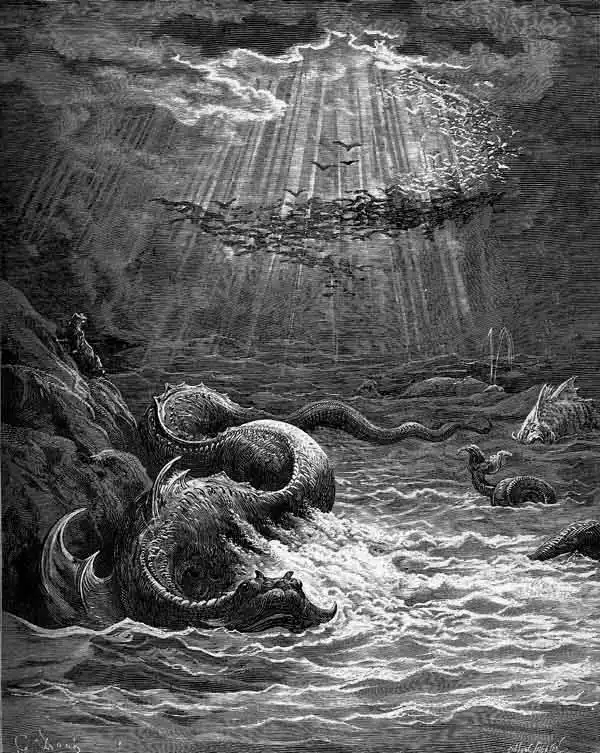
God creates the fish and the birds, bu Gustave Doré c. 1868.
This distinct order is puzzling. Why would he begin with creatures of the sea and the air, before making those who walk on earth? The reason must be that he finishes his creation with making man, so the order of creation is one of approaching that final act. Animals at sea and in the sky are the farthest from man, whereas those creatures walking beside him on earth are the ones closest to him, so they are made right before man is.
On the fifth day, though, life is brought to the sea and ordered to multiply. The birds, too, and here the text admits that they may roam the sky, but they settle on earth in order to multiply — with their nests and such.
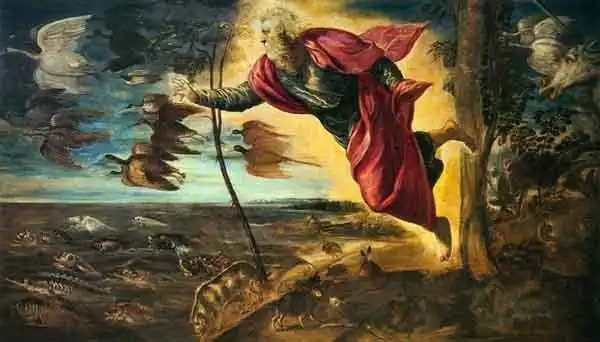
God creates the land living animals, by Jacopo Tintoretto 1552.
The sixth day
Genesis 1 : 24-31
On the sixth day, God creates all the land living creatures, ending with the creation of man, adam, in his own image. Here, clearly, the word adam refers to mankind, the human being. In this creation story, God makes mankind in two genders to begin with, male and female (zakar and neqebah).
The intriguing part of it is that makind is made in Gods image, tselem. The word refers to a shade, implying a resemblance of something that is clearly not the same as the original. What this resemblance is has been discussed all through the centuries. Since there is no clue as to the nature and form of God, there is no way to ascertain in what way mankind can be compared to him.
Primarily, it states that the world of God's creation is mainly something for mankind to rule and use to its own benefit. This is confirmed in verse 28, where God tells mankind to replenish and subdue the earth. Kabash, subdue, is very distinct. It means to subjugate, even to violate, without hesitation. God gives the earth, its vegetation, and its animals, for man to eat and use as he sees fit. Man is given total power over the world to which he is born. Although not clearly stated, Genesis 1 ends with the whole world being created for mankind, without any obligations attached to it.
The dominion of man is so evident that the whole creation process could be read backward. God made a world for man to inhabit and feed off. The story would make the same sense if he had started by creating man as his image, and then spent the six days on making a world for this species to live in. Even though the creation of man was last, God must have had this in mind all through the process. It was his goal.
That is far from the case in other creation myths. Often, these stories are lengthy about the appearance of gods and other supernatural creatures, whereas the appearance of man is little more than an annoyance to the gods. In the Babylonian creation Enuma Elish, mankind is created at the end of the great battles between the gods, and for the sole purpose of serving them.
Genesis 1 makes man the very goal of God's work, and the highlight of it. This is possible, if not necessary, in a monotheistic creation. Where there is but one god, man becomes his sole mate, and therefore just about as important as he is. In a mythology of multiple gods, man's importance is necessarily diminished.
On the other hand, there is the anomaly of the plural form used for God in Genesis 1. Possibly, it is a rest from a time when the Hebrews believed in several gods, like their neighboring cultures. Also, when God creates mankind in his image, he does so with two genders, which is stated in the same sentence. That might imply a divine duo, a god and a goddess. If so, it must be in an earlier version of the story, long lost to the Hebrews, since there is no hint of a goddess anywhere else in the Bible.
Still, it is more likely that the resemblance of man to his creator is of another kind, either in capacity or in rulership. The latter is evident: God rules the all, but assigns for man to rule the Earth. God retreats to his Heaven and only returns to Earth when man shows serious misconduct in his rulership of it. It is the normal relation between a king and his vassals.
Is there another similarity between God and mankind that the text refers to? God is vaguely described, certainly, but two traits are found — one is his spirit, or breath, and the other is his connection to light. To the former belongs his commanding voice. Both spirit, ruach, and voice were regarded as human properties as well. To that extent, God seems somewhat anthropomorphic. The light, though, if that is indeed one of God's characteristics, sets him apart from mankind. The repetition of days passing during God's creation of the world underlines this difference. He brings light to the world — the one thing that the world was unable to do perform by itself, and also the very thing that was the prerequisite for the rest of creation. Therefore, he did his creative work during daytime, only.
The many ways by which light is made the central element of this creation story suggest that the Hebrew god had its origin in some kind of solar worship, although the sun appears later on in the creation process. The essence of the sun is its light, and the many evident wonders it accomplishes on earth. So, indeed the divine ingredient in a sun god must be its light.
If the cosmology of Genesis 1 has evolved from some kind of sun cult, it would help to explain the monotheism, which is quite rare in mythology. A pure monotheism is hard to find outside Judaism and its two followers, Christianity and Islam. But where the sun is regarded as the creative divinity, it would be quite hard indeed to find another celestial or terrestial power to compare to it. In any case, it would not be out of question to develop a strict monotheism from such a perspective.
The seventh day
Genesis 2 : 1-3
The first creation story of the Bible does not end with the first Chapter of Genesis, but continues through the first three verses of Genesis 2. This is slightly confusing, but there is no cause for reading substantial things into it. Most likely, it is the result of some editorial mistake early on, which has remained because of the respect for this sacred text. Nobody dared rearrange it, in spite of the obvious inconsistency.
Since the seventh day is the one where God rests from his work, and therefore declares it sanctified (qadash, indicating cleansed or purified), it may be a later addition in order to justify the Sabbath. That might explain why it landed in the following Chapter. Actually, the whole division of God's creative work into six days may be a later editing of the creation story. Some of the events seem to have been rather haphazardly divided into days. Here are the days and what God did on them:
- Creation of light
- Creation of the firmament
- Drying of the land and creation of the vegetation
- Creation of the celestial bodies
- Creation of the sea creatures and the birds
- Creation of the land creatures and man
The fourth day's creation of the celestial bodies is reasonable, since it is all a matter of creating the heavenly instruments that give base for the calendar, marking the seasons and so forth. Still, because if this function, this part of creation would fit better right after the creation of the firmament. And the fact that God introduces light before he creates the body that henceforth delivers it, strongly suggests that light is an essence of his — automatically coming wherever he is going.
The creation of fish and birds on day five could just as well be divided into two days of work, as could the sixth day creation of animals and men, since God makes clear that the latter are what it is all about. Considering the importance he gives to mankind, it is surprising that he does not spend one day solely on their creation.
So, the division of creation into six days is not that clearly confirmed by the series of events. An original creation myth might even have lacked a division into days completely, except for introducing the very first one. It may all have been one day's work. Alternatively, there may have been a previous version where light was not introduced until the sun was created, together with the other heavenly bodies. In such a story, creation would have started with the separation of the waters into a firmament and the sea. Then, the following act of moving the sea away from the land follows quite naturally. The sun, moon, and stars could not have been created until there was a firmament on which to put them, so the moment of their creation is quite fixed. So is, more or less, the rest of creation.
The division into days adds a poetic dimension to the creation story, a twist that is significant and sticks to memory. The repetitious pattern it brings to the story has its counterpart in many other creation myths around the world. Since the world is vast and contains a lot, any report on its creation is likely to approach the form of a list: first this, then that, then that... Since this is unavoidable, a poet finds a way of decorating the list to make it more pleasing.
Also, the repetitious pattern is typical for orally transmitted stories and myths. This form of Genesis 1, as well as the very dense structure of it, suggests that there is an oral tradition behind it, and one that has not been altered much for its written form. What may have changed is the way God was perceived at the time of writing down this creation story. Any alterations of the story would then have been made in order to fit it to this God.
3 Good for man
Genesis 1 Creation
The first creation of the Bible
- Genesis — The Text
- The seven days
- Good for man
- Commentaries
- Augustine of Hippo
- Martin Luther
- Some conclusions
This article was originally written for a seminar at the Department of History of Ideas and Learning, Lund University, as a part of my dissertation in progress on creation myths and their patterns of thought. Transforming the text to webpages, I have excluded footnotes, or edited them into the text.
Some of My Books:Click the image to see the book at Amazon (paid link).
The Greek philosophers and what they thought about cosmology, myth, and the gods. |
MENU
Creation Myths Around the World
How stories of the beginning began.
The Meanings of Mythology
Theories through history about myth and fable.
Archetypes in Myths
The mythological symbols and what they stand for.
The Logics of Myth
Patterns of creation.
Contact
About Cookies
CREATION MYTHS IN DEPTH
Creation in Rig Veda 10:129
The paradox of origin, according to an Indian myth.
Genesis 1
The first creation story of the bible scrutinized.
Enuma Elish
The ancient Babylonian creation myth.
Xingu Creation of Man
The insoluble solitude of gods and humans.
ON MY OTHER WEBSITES
Psychoanalysis of Myth
What Sigmund Freud and C. G. Jung thought about myths, their origins and meanings.
Myth of Creation
An introduction to the subject of creation myths and the patterns of thought they reveal.
Cosmos of the Ancients
What the Greek philosophers believed about the cosmos, their religion and their gods.
Life Energy
The many ancient and modern life force beliefs all over the world explained and compared.
Taoistic
Taoism, the ancient Chinese philosophy of life explained. Also, the complete classic text Tao Te Ching online.
 Stefan Stenudd
Stefan Stenudd
About me
I'm a Swedish author and historian of ideas, researching the thought patterns in creation myths. I've also written books about Taoism, the Tarot, and life force concepts around the world. Click the image to get to my personal website.
 Archetypes of Mythology
Archetypes of Mythology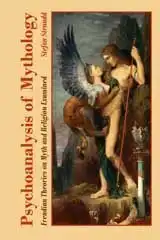 Psychoanalysis of Mythology
Psychoanalysis of Mythology Cosmos of the Ancients
Cosmos of the Ancients Life Energy Encyclopedia
Life Energy Encyclopedia Sunday Brunch with the World Maker
Sunday Brunch with the World Maker Fake Lao Tzu Quotes
Fake Lao Tzu Quotes